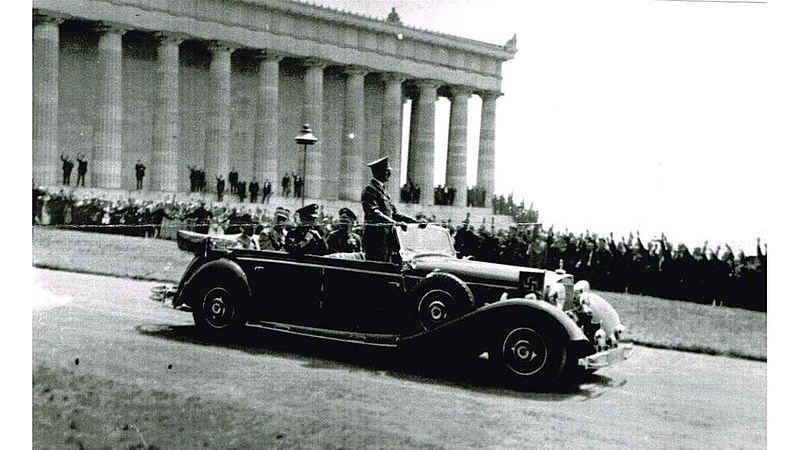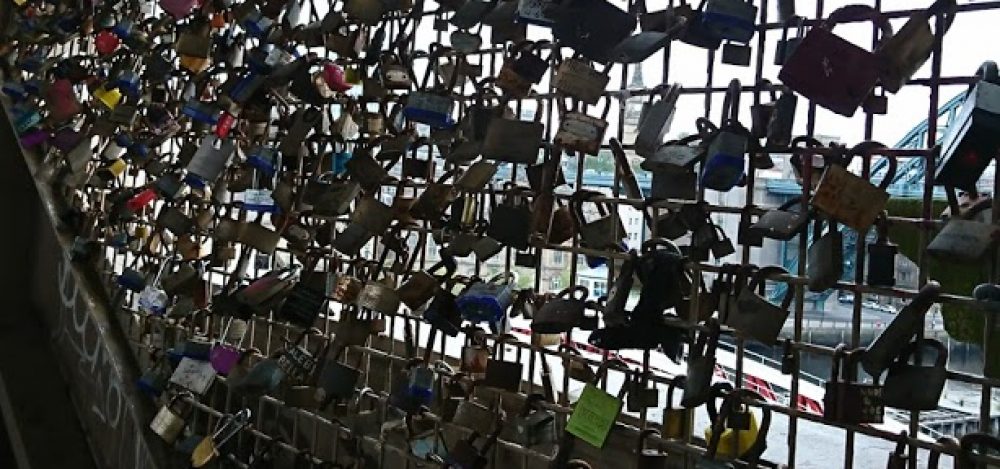How Oral History helped to disrupt the appropriation of the ‘White Rose’ resistance
This year’s [2022] Brundibár Arts Festival was opened by Silvie Fisch of the Oral History Collective. The annual festival is dedicated to the music and arts of the Holocaust. This year’s festival theme is inspirational women and Silvie spoke about the changing public history of Sophie Scholl. Here is an edited version of Silvie’s talk.
The case of the German ‘White Rose’ Second World War resistance group exemplifies how oral histories can play a crucial, if limited, role in challenging dominant public history narratives.
Between 1942 and 1943 ‘White Rose’ activists produced and disseminated half a dozen pamphlets calling on the German people to resist Nazism. The core of the group consisted of six people: the siblings Hans and Sophie Scholl, Christoph Probst, Alexander Schmorell, Willi Graf and Kurt Huber.
A version of the ‘White Rose’ story had already become known in Britain before the war’s end, thanks to a BBC broadcast by the German novelist in exile Thomas Mann. Copies of the group’s last pamphlet, which had been smuggled to England by Helmuth James Graf von Moltke – a founding member of the Kreisau Circle dissident opposition group – were dropped over Germany by Allied planes in mid-1943.
On 18 February 1943 Hans and Sophie were caught, depositing copies of the sixth pamphlet inside Munich University. Four days later Hans, Sophie, and Christoph were sentenced to death and executed by guillotine, just hours after the conclusion of a show trial. Alex, Willi, and Kurt Huber were arrested and sentenced to death soon after. Alex and Kurt Huber were executed on 13 July. Willi Graf was the last to lose his life, on 12 October 1943.

Celebrated in the immediate post-war years as part of the resistance, the subsequent Cold War turned them into anti-communist heroes in the West, while the East of Germany celebrated them as doughty antifascist socialists. There were many other, larger, resistance groups, such as the ‘Red Orchestra’ with over 400 members, however, in contrast to the core members of the ‘White Rose’, their individual lives remain unknown.
Then, during the 1960s and 1970s the reputation of the group began to be challenged – at least in West Germany. A young, angry generation was no longer simply interested in what had happened during the war, but also how former Nazis, including potential perpetrators of atrocities, had remained in powerful positions in West German society.
Up until this point, Hans’ and Sophie’s sister Inge Aicher-Scholl had been viewed as a keeper of resistance memory and an undisputed authority in recounting the ‘White Rose’ history. Her autobiographical memories had made her siblings the stars of the movement, much to the dismay of other members’ relatives, and had shaped public understanding of the group and resistance narratives more widely. When she reached the limits of her knowledge she quoted from unreferenced written and oral sources. As a close relative she was publicly perceived as an authentic witness, additionally a wealth of material only became available for research after her death in 1998.
However, three decades before Inge died, the ‘White Rose’ story had been disrupted – at least for a time. In 1968, the young historian Christian Petry published Studenten aufs Schafott. Die Weiße Rose und ihr Scheitern [Students on the Scaffold. The White Rose and its Failure]. Petry conducted oral history interviews with family members, friends, and acquaintances of the group. This was the first comprehensive historical ‘White Rose’ account to be published. Not only did Petry’s work direct attention away from the siblings and towards other group members, but he also challenged the existing myths surrounding the group. In the same year, he co-produced the television documentary Die Weiße Rose – Abschied von einem Mythos (The White Rose – Farewell to a Legend) which has recently (October 2021) been rebroadcast on German national public TV.[1] Inge Scholl lost her absolute authority to a combination of published historical research and a popular media presentation.
George Jürgen Wittgenstein, who took the iconic photograph of Sophie at the fence of Munich’s Ostbahnhof, pointed out in 2004:
Inge Aicher-Scholl had had had no direct knowledge of the White Rose during her siblings’ lifetime, nor about their activities. (…) Christian Petry published an impressively well-researched and objective book in 1968. It contains details and documentation which still hold true today but have not been accessed frequently enough. Unfortunately, most subsequent books (with two exceptions) lack thorough independent research and are, to a large extent, re-writes of Inge Aicher-Scholl’s book.[2]
The story of the ‘White Rose’ might have fallen into oblivion, had it not been for the 1980s American television series Holocaust which redirected people’s interest towards individual personal histories. One consequence of the series was a renewed search for positive historical figures to demonstrate that there had been some good amongst the evil.
The myths and legends were also fuelled by popular histories. A key example is Sophie Scholl and the White Rose by Annette Dumbach and Jud Newborn. Originally published as Shattering the German Night in 1986 in the United States, the book was then reissued under its new title in 2006, and again on the 75th anniversary of the executions, with a foreword by the US oral historian Studs Terkel. Both enjoyed and criticised by readers for the publication’s ‘suspense novel’ style, the book freely mixed fact and fiction and lacked detail in recounting the complexities of young people’s lives present in Petry’s earlier work.
It was the post-unification period, and the search for heroes who could satisfy both sides of the former wall, that pushed Sophie Scholl into the role of an icon. Sophie became a staple of institutionalised commemoration in reunited Germany. Her personality was reduced to that of an innocent, almost saintly woman. She became a picture on a stamp, a cult figure, the only woman in the top 10 of the most admired Germans in history. Of course, the real Sophie, who was only 21 when she died, was a young, fascinating woman with flaws and rough edges. From what we know from her diaries and letters, she battled bouts of depression, struggled with Christian sexual morality, and was never free of self-doubt.

On 22 February 2003, the 60th anniversary of her execution, a white marble bust of Sophie Scholl was unveiled in the Walhalla, a pompous, nineteenth-century neo-classical temple close to my hometown of Regensburg. Its architecture was originally intended to symbolise Germany’s greatness and its ‘Hall of Fame’ contains, to date, 131 sculptures of ‘outstanding’ people in German history (only 13 of them are female). It was also already established as a popular visitor attraction and was heavily promoted by the Nazis. At the beginning of 1937 Adolph Hitler visited Walhalla with Joseph Goebbels, Heinrich Himmler, and numerous guests of honour, to unveil the bust of the composer Anton Bruckner. Many, including ‘White Rose’ family members, expressed concern, not only about the site’s questionable past but also because they were convinced that Sophie would have objected to being presented as the group’s centrepiece in such a setting.
In recent years, the “White Rose” history has taken a further, macabre turn. The guillotine used in the ‘White Rose’ executions was discovered in 2014, by a journalist in the depot of the Bayerisches Nationalmuseum. Museum staff had known for many years that the machine was in their stores but had decided not to put it or its history on display. And after a brief and internal discussion, the Bavarian Government decided that’s where and how it should stay. Their public statement said they were worried about the ‘voyeuristic inclinations’ of museum visitors and wanted to protect the dignity of the victims and their families. But some of the family members, together with politicians and historians felt that this was the wrong decision, that we need these objects on display to illustrate the brutality of the regime, to cause an emotional response that can result in a better understanding, an interest in learning and the capacity to confront those forces who currently attempt to endanger our democratic foundations.
The narrative of resistance has been appropriated to fit different agendas over time. How we commemorate, what we commemorate – and what we do not – exposes cracks within society.
The argument continues into post-memory.
Selected Literature
Chaussy, U.; Ueberschär, G. R. (2013). ‘Es lebe die Freiheit!’: Die Geschichte der Weißen Rose und ihrer Mitglieder in Dokumenten und Berichten. Frankfurt am Main: Fischer.
Dumbach, A.; Newborn, J. (2018) Sophie Scholl and the White Rose. London: Oneworld Publications.
Hikel, C. (2010) Lügengeschichten, Sensationsromane und andere Machwerke : Vergessenes von der ‘Weißen Rose’. In: WerkstattGeschichte 2009 (52) pp. 23-37.
Hikel, C. (2013) Sophies Schwester. Munich: Oldenbourg Wissenschaftsverlag.
Lloyd, A. (ed.) (2019) The White Rose: Reading, Writing, Resistance. Oxford: Taylor Institution Library.
Niven, B.; Paver, C. (2009) Memorialization in Germany since 1945. New York: Palgrave Macmillan.
Petry, C. (1968) Studenten aufs Schafott. Die Weiße Rose und ihr Scheitern. München: Piper.
Probst M. (2021) Die vielen Leben der Sophie Scholl. At https://www.zeit.de/2021/18/sophie-scholl-nationalsozialismus-widerstand-weisse-rose (Accessed 25/01/2022).
Scholl, I. (1983) The White Rose: Munich, 1942–1943. Middletown, CT: Wesleyan University Press.
[1] See https://www.ardmediathek.de/video/doku-und-reportage/die-weisse-rose/radio-bremen/Y3JpZDovL3JhZGlvYnJlbWVuLmRlLzcwOWFlNzc4LTFiYTctNGQxMi04NzJjLWZkYWM3ZjU2ZGZjMw/ (Accessed, 27 January 2021).
[2] Wittgenstein, G.J. (2004) ‘The White Rose: A Commitment’. In: Michalczyk J. Confront! Resistance in Nazi Germany. New York: Lang p.192.
